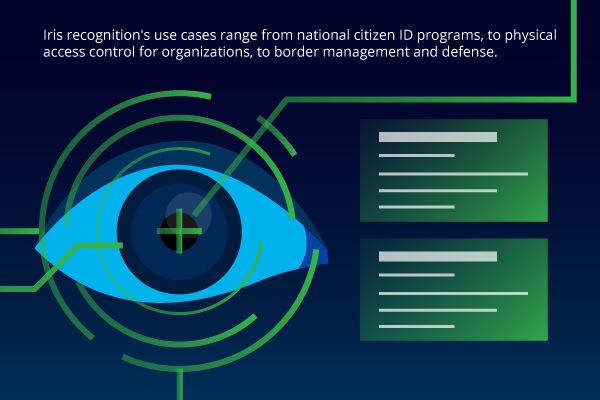Iris Recognition Software
Biometrics make use of our most unique physical features and behaviors to serve as digital identifiers that computers and software can interpret and utilize for identity-related applications. They can be used to identify someone in a biometric database, or to verify the authenticity of a claimed identity. Our irises are useful as a biometric.

The iris a muscle in the eye that regulates pupil size. Ophthalmologists confirmed in the 1980s that the patterns on the iris are unique to each individual. This led to the development of iris recognition technology for identity verification in the mid ’90s.
A broad patent for iris recognition expired in 2005 which opened it up to a bigger market. Today, iris recognition technology is used as a form of biometric identification that can verify the uniqueness of an individual with exceptional accuracy.
Note that iris recognition is not to be confused with retina recognition. The latter establishes uniqueness using the arrangement of blood vessels on the retina at the back of the eye.
Iris scanning process
There are four main steps involved in iris recognition enrollment for use as a form of biometric authentication:
1. Image capture
A high-quality image of the individual’s left and right iris must be captured using a specialized iris camera. These cameras use near-infrared (NIR) sensors to capture the minute and intricate details of the iris with much greater accuracy than visible light (VIS), which can pollute the sample. Research from Michigan State has determined that iris recognition accuracy drops significantly when VIS is used instead of NIR. Visible light is also more at risk of causing discomfort and pupil contraction when shined into a subject’s eyes. By comparison, near IR causes neither pupil contraction nor discomfort during an iris scan.
2. Compliance check and image enhancement
The next step is to perform quality and compliance checks to ensure that the captured image is suitable as a biometric template for future iris scanning. This requires specialized software that analyzes each image for key characteristics that indicate quality, including, but not limited to:
- Sharpness.
- Gray-level spread.
- Margin.
- Iris sclera contrast.
- Iris pupil contrast and pupillary dilation.
- Eyelash presence.
- Eyelid occlusion.
Once the iris has been segmented from the rest of the eye and evaluated for quality, the sample can be saved for future use as a biometric template.
3. Image compression
Each iris-scan template should be compressed using the JPEG 2000 format. This format preserves image quality and minimizes the occurrence of artifacts (image distortions) that result from other compression methods.
4. Biometric template creation for matching
Finally, the high-quality sample is put to use as a template for iris scanning.
In one-to-one authentication, each live scan of an individual’s iris is compared to the existing template for identification and authentication. In one-to-many authentication, a live scan is analyzed and compared against an existing gallery to identify a match or lack thereof.
Advantages and disadvantages of iris recognition
Iris biometrics have several unique advantages when used for identification and authentication. These include:
- No physical contact when scanning (more sanitary).
- Accurate matching performance.
- Can be captured from a distance (with advanced software and optics).
- The iris is protected by the cornea so it doesn’t change much as people age.
- Difficult to spoof.
Disadvantages of iris scanning include:
- Can’t use a regular camera; requires IR light source and sensor. Visible light must be minimized for highest accuracy required for search.
- Generally require close proximity to camera, which can cause discomfort for some.
- Less value for criminal investigation (no latents) .
Use cases
Iris recognition’s use cases range from national citizen ID programs, to physical access control for organizations, to border management and defense. Iris recognition can also be used as a form of mobile authentication on those devices with special IR-enabled cameras; for example, the Samsung Galaxy S8 and S9.
Aware products for iris recognition
Aware offers the following iris recognition products:
- Nexa|Iris: Iris matching algorithm SDK.
- IrisCheck: SDK for automated quality analysis and compliance assurance biometric iris images.
- AwareABIS: Automated biometric identification system.
Click here to learn more about Aware’s portfolio of iris recognition products and services.



